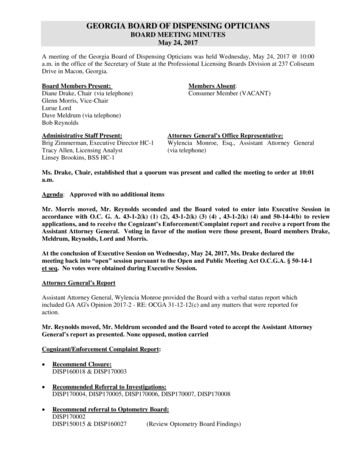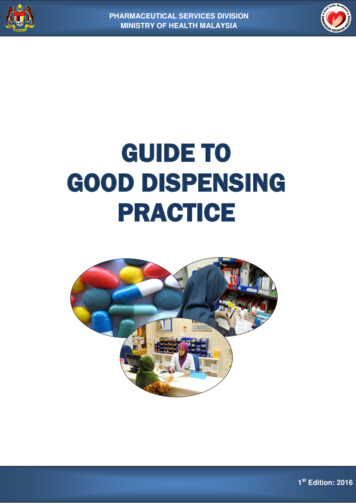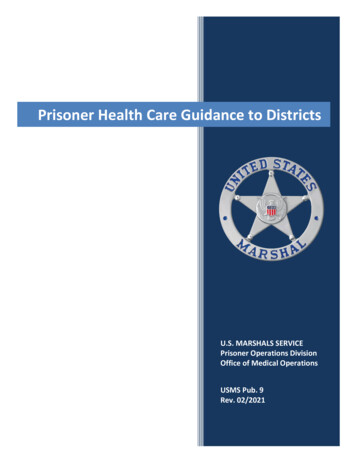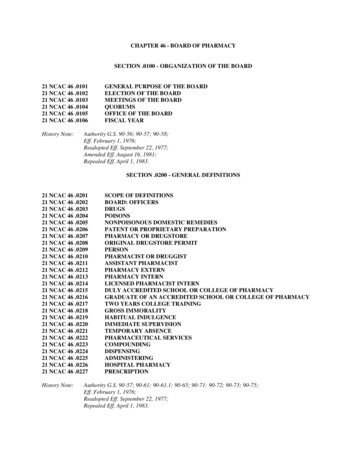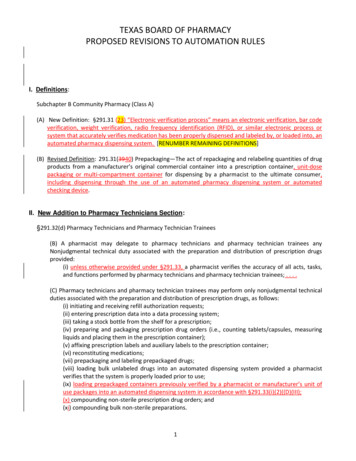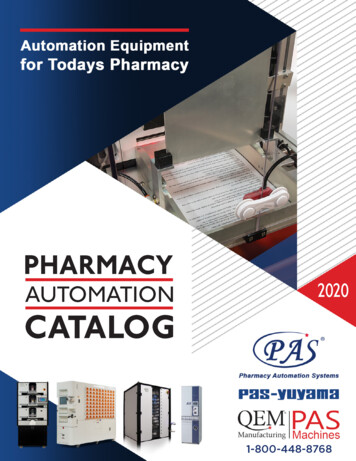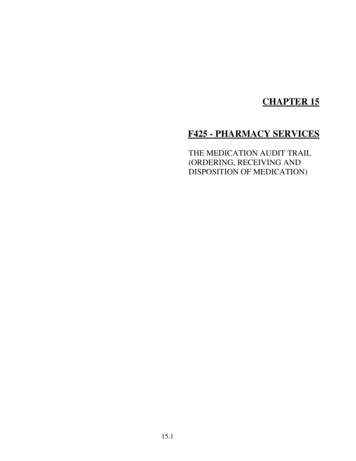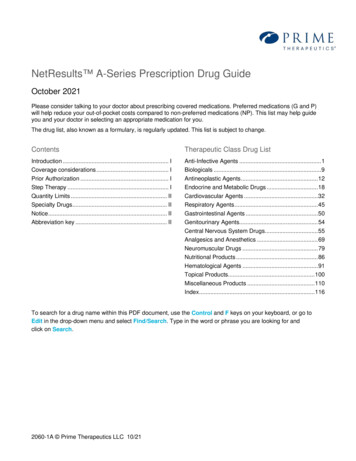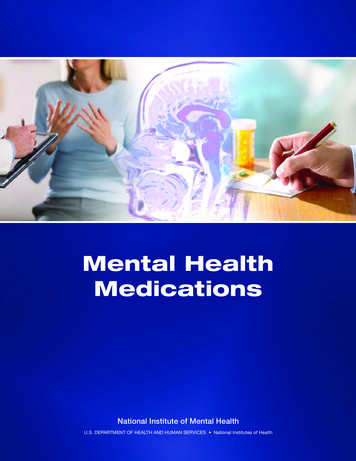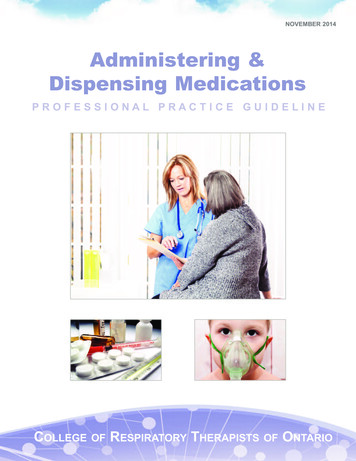
Transcription
NOVEMBER 2014Administering &Dispensing MedicationsPROFESSIONAL PRACTICE GUIDELINECOLLEGEOFRESPIRATORy ThERAPISTSOFONTARIO
Administering & Dispensing Medications Professional Practice GuidelineProfessional Practice GuidelineCollege of Respiratory Therapists of Ontario (CRTO) publications contain practice parameters andstandards which should be considered by all Ontario Respiratory Therapists in the care of theirpatients/clients and in the practice of the profession. CRTO publications are developed in consultationwith professional practice leaders and describe current professional expectations. It is important to notethat these CRTO publications may be used by the CRTO or other bodies in determining whetherappropriate standards of practice and professional responsibilities have been maintained.Resources and references are hyperlinked to the Internet for convenience and referenced to encourageexploration of information related to individual areas of practice and/or interests. Bolded terms aredefined in the Glossary.It is important to note that employers may have policies relatedto an RT’s ability to accept delegation to dispense medications. Ifan employer’s policies are more restrictive than the CRTO’sexpectations, the RT must abide by the employer’s policies.Where an employer’s policies are more permissive than theexpectations of the CRTO, the RT must adhere to the expectationsof the CRTO.2nd Revision: November 2014Originally Published: 2005Page 2
Administering & Dispensing Medications Professional Practice GuidelineINTRODUCTIONtable of contentsADMINISTRATIONThe 9 “Rights” of Competent Medication AdministrationMedication Management SystemsOral and Topical MedicationOver the Counter (OTC) Medication456667DISPENSINGWhen it’s Appropriate for an RT to DispenseAccepting Delegation to DispenseWho an RT Can Accept Delegation FromTABLE 1: Who can order medication and who can order dispensing medication.Orders for DispensingFactors to Consider when Accepting Delegation to DispenseLabeling dispensed medicationSafe storage and handling88991010101111DOCUMENTATION12DISPENSING PROCESS MAP13SPECIAL CONSIDERATIONSSubstitution PoliciesRepackagingNarcotics and other Controlled SubstancesDispensing SamplesMedication Errors141414141516Glossary17References18Page 3
Administering & Dispensing Medications Professional Practice GuidelineIntroductionThe Regulated Health Professions Act, 1991 (RHPA) identifies thirteen controlled acts that posesignificant risk of harm to the public of Ontario [RHPA section 27(2)]. Dispensing medications fallsunder the 8th controlled act in the RHPA:“Prescribing, dispensing, selling or compounding a drug as defined in the Drug and PharmaciesRegulation Act, or supervising the part of a pharmacy where such drugs are kept.”The Respiratory Therapy Act, 1991 (RTA) does not authorize Respiratory Therapists (RTs) to performthis controlled act, the authority to dispense medications must be delegated to an RT from anotherregulated health care professional that is authorized to dispense and to delegate dispensing (i.e.,physicians). Therefore, RT’s can only receive delegation for the dispensing portion of this controlledact. Respiratory Therapists must not prescribe, sell or compound a drug, or supervise the part of apharmacy where such drugs are kept.Please Note Other regulated health care professionals who are authorized to perform this controlledact in its entirety, or parts of it, have additional regulations and standards guiding thesepractices. For example, only Pharmacists and wholesalers are permitted to sellmedications. Selling implies the possession of the medication. RTs cannot acceptpayment for medications dispensed or invoice clients on behalf of their employers.For additional information, please see the Interpretation of Authorized Acts and Delegation ofControlled Acts Professional Practice Guidelines (PPGs).Other legislation regulating the practices of prescribing, dispensing, selling, or compounding a drug,and supervising a pharmacy, includes but is not limited to:Provincial Legislation: Pharmacy Act, 1991 Drug and Pharmacies Regulation Act, 1990 Drug Interchangeability and Dispensing Fee Act, 1990 Narcotics Safety and Awareness Act, 2010Federal Legislation: Food and Drugs Act, 1985 Controlled Drugs and Substances Act, 1996 Narcotics Control Regulation (amended 2014)Page 4
Administering & Dispensing Medications Professional Practice GuidelineADMINISTRATIONRTs commonly administer medications via theauthority granted to them by the RespiratoryTherapy Act - “administering a substance byinjection or inhalation” [s.4 (4)]. Dispensing occursless often, and will be explained later in this PPG.RTs are responsible for administering medicationswithin both their personal and professional scope ofpractice. The safe and competent administration ofmedication requires the RT to have thecompetencies (knowledge, skill and abilities) to: Examples of administeringmedication: assess the appropriateness of a particularmedication for the patient/client, includingindications and contraindications;Obtaining, preparing and administering anarcotic for use during conscious sedationof a patient/clientObtaining, preparing and administering adrug from a supervised hospital ordepartmental “stock” of medications (e.g.sedatives kept in a bronchoscopy suite foruse during an outpatient procedure)be aware of the actions, interactions, dose, route, side-effectsand adverse effects of the drug;be able to calculate the correct dosage and prepare themedication correctly, when necessary; andto monitor the patient/client during and followingadministration, as well as manage any side-effects or adversereactions to the drug, intervening when necessary.* Prior to administering any substance, the Respiratory Therapy Act requires RTsto obtain a valid order (direct order or medical directive) from:(a) a member of the College of Physicians and Surgeons of Ontario, the Collegeof Midwives of Ontario or the Royal College of Dental Surgeons of Ontario;(b) a member of the College of Nurses of Ontario who holds an extendedcertificate of registration under the Nursing Act, 1991; or(c) a member of a health profession that is prescribed by regulation.Page 5
Administering & Dispensing Medications Professional Practice GuidelineThe 9 “Rights” of Competent Medication Administration1.2.Please Note Dispensing canonly occur once.After a drug islabeled anddispensed to apatient/client viaan automatedmedicationdispensing unit,physically givingthe medication tothe patient/clientis administration,not dispensing.3.4.5.6.7.8.9.right PATIENT/CLIENT –should be at least two unique identifiers (not roomnumber);right MEDICATION to be given - compare Medication AdministrationRecord (MAR) with order;right ROUTE– includes site (e.g., IV, IM);right TIME/ DAY – includes frequency;right DOSE – check calculation and label;right DOCUMENTATION – i.e. after medication is administered;right FORM – e.g. liquid, tablet, etc.;right REASON – to treat the appropriate condition; andright RESPONSE - monitor to ensure that the medication has the desiredeffect1.Medication Management SystemsMost facilities now use some form of medication management system, whichusually includes an automated medication dispensing unit. The purpose ofimplementing this type of delivery system is to avoid preventable medicationerrors and improve patient safety. The pharmacy receives the medication orderelectronically from the physician and dispenses the medication into the unit. Themedication can then be accessed by staff to be administered when needed.Oral and Topical MedicationAdministration of a substance orally or topically is not a controlled act under theRHPA and is not considered dispensing unless a supply was given to thepatient/client to take at another time. An RT may assist a patient/client in takingtheir prescribed tablets at the time they are due; however, an RT may not leaveextra tablets from a stock at the bedside for the patient/client to take. As with allother medications, to administer oral (e.g., Prednisone) and topical medications(e.g., Lidocaine) the RT needs to know the indications, contraindications, properdosages and potential side-effects. The prescription and medication containermust be checked, along with the patient/client’s identity and any potentialallergies/drug sensitivities, as with any other medication. Oral medications in atablet form should be given to the patient in a disposable container, and liquidpreparations should be measured using syringes specifically designed for thatpurpose. The RT must ensure that the medication was taken by the patient/clientas directed, and document accordingly.1 Koppel, R., Wetterneck, T., Telles, J. L., & Karsh, B. T. (2008). Workarounds to barcodemedication administration systems: their occurrences, causes, and threats to patient safety.Journal of the American Medical Informatics Association, 15(4), 408-423.Page 6
Administering & Dispensing Medications Professional Practice GuidelineOver the Counter (OTC) MedicationOTC refers to medications that can be obtained in the community without a prescription froman authorized regulated health care professional. However, in a hospital setting an order is stillrequired to administer an OTC medication. Many facilities also have policies requiring that anyOTC medication brought in from home by a patient/client must be sent to the pharmacy forlabelling, and then approved by the most responsible physician before returning it to thepatient/client.If an RT is giving out OTC medication in a community setting (e.g., nicotine replacement therapyor NRT in an outpatient smoking cessation clinic), they are responsible for ensuring themedication is stored securely and must dispose of any medication that is past its expiry date.For more information, please see the section on Safe Storage and Handling.Q&AQ: In order for me to hand out OTC NRT in our FamilyHealth Team, do I need to get delegation to dispense?A: OTC medication does not require an order from aphysician in the community and is not “dispensed”.Therefore, RTs do not need delegation in order to provideOTC NRT to a patient/client to take home.Page 7
Administering & Dispensing Medications Professional Practice GuidelineDISPENSINGExample:Allowing a patient/client totake home a properlylabeled metered doseinhaler from the EmergencyDepartment stock aftercounseling a patient/clientabout their prescription andmedication.RTs do not have the legislative authority to dispense medication,but can receive delegation to dispense. RTs may dispensemedications when it’s in the best interest of the patient/client, suchas a patient/client having difficulty accessing a pharmacy.Dispensing is a controlled act that authorizes an RT to select,prepare and provide stock medication that has been prescribed to apatient/client (or his or her representative) for administration at alater time.The process of dispensing has both technical and cognitivecomponents. The technical component includes tasks such asreceiving and reading the prescription, selecting the drug todispense, checking the expiry date, labeling the product, and recordkeeping.The cognitive component of dispensing involves assessing thetherapeutic appropriateness of the prescription, applying approvedsubstitution policies, being able to make recommendations to theprescriber and advising the patient/client.When it’s Appropriate for an RT to DispensePlease note Only RRT Members of the CRTO (subjectto any terms, conditions and limitationson his/her certificate of registration thatare related to accepting delegation and/ordispensing) may receive delegation todispense medications.Example:Providing a patient/client with apharmaceutically supplied sample of amedication to take home from an asthmaclinic. (For more information, please seethe section on Dispensing Samples.)Page 8Registered Respiratory Therapists (RRTs) requiredelegation to dispense medication. It is important tonote that Graduate Respiratory Therapists (GRTs)cannot accept delegation for any controlled act,including dispensing.Depending on an RT’s personal scope of practice, itmay be practical and in the best interest of thepatient/client for an RT to accept delegation todispense medications in certain practice settings,such as: hospital emergency departments; asthma care centres; pulmonary function laboratories; cystic fibrosis care centres; respiratory rehabilitation centres; COPD care centres; polysomnography laboratories; and Family Health Team (FHT).
Administering & Dispensing Medications Professional Practice GuidelineAccepting Delegation to DispenseThe delegation to dispense medication requires the same steps as any otherdelegation process. For additional information, please see the CRTO Delegation ofControlled Acts PPG. The Federation of Health Regulatory Colleges of Ontario(FHRCO) also has resource information and templates for developing delegationprocesses, which can be accessed on their website es/default.aspWho an RT can accept delegation to dispense fromThe following are health care professions authorized to dispense medication andwho RTs can accept orders to dispense from: Dentists; Physicians; Pharmacist Nurse Practitioners Midwives.For more information regarding health care professionals who can dispensemedication, please see the FHRCO Interprofessional Collaboration (IPC) eTool.Please Note As of January 1,2014, RNs and RPNsare authorized todispense medicationsprovided they havean order for themedication from anauthorized provider.However, RNs/RPNscannot delegatedispensing (CNO,Medication, 2014).Please Note RTs require both an order for the medication AND an orderto dispense the medication. However, it does not have to besame healthcare professional who provides both. Forexample, a physician can write the order for the medicationand a pharmacist can delegate dispensing of thatmedication. For more information, please see TABLE 1.Page 9
Administering & Dispensing Medications Professional Practice GuidelineTable 1: Who can order medication and who can order dispensing medication.healthcare ProfessionalPhysicianNurse PractitionerMidwifeDentistPharmacistReg. Nurse/Reg. PracticalNurseAbility to OrderMedicationAbility to Order theDispensing of MedicationPPPPPOOPPPPOOrders for DispensingAn order to dispense must include the following: order date, client name, medication name, dose in units, route, frequency, purpose, quantity to dispense; and prescriber’s name, signature, and designation.Factors to Consider when Accepting Delegation to DispenseReminder.Respiratory Therapistsare reminded that theyare not obligated toaccept delegation todispense medications ifit is, in their judgment,not appropriate to doso. For moreinformation, please seethe CRTO Delegation ofControlled Acts PPG.Page 101. Is your certificate clear of any terms, conditions or limitations thatprevent you from dispensing or accepting delegation to dispense?2. Do you reasonably believe that the person who delegateddispensing to you has the authority and the competence to do so?3. Do you have the competence to dispense medication?4. Is it appropriate and in the best interest of the patient/client thatyou accept delegation to dispense medication, given the knownrisks and benefits?5. Are there other controlled acts involved and are you authorized toperform them?
Administering & Dispensing Medications Professional Practice GuidelineLabelling Dispensed MedicationIf medication is being dispensed based on a prescription, the label must meet all therequirements outlined in the Drugs and Pharmacies Regulation Act (s.156 (3) –Identification Markings), which means that the container in which the drug isdispensed shall be marked with:(a) the identification number that is on the prescription;(b) the name, address and telephone number of the pharmacy in which theprescription is dispensed (if applicable);(c) the identification of the drug as to its name (preferably both generic andtrade name), its strength (where applicable) and its manufacturer, unlessdirected otherwise by the prescriber;(d) the quantity where the drug dispensed is in solid oral dosage form;(e) the name of the owner of the pharmacy (if applicable);(f) the date the prescription is dispensed;(g) the name of the prescriber (along with professional designation (e.g., MD);Please note The label can behandwritten orcomputer generated.However, it’s importantthat: the informationcontained on thelabel is legible; and the dispensedmedication isadded to thepatient’s/client’srecord.(h) the name of the person for whom it is prescribed;(i) the directions for use as prescribed.Safe Storage and HandlingIf an RT is responsible for maintaining a supply of medication, they must be sure to: Keep an up-to-date inventory of all medication in stock; Check to see if medications require refrigeration; Ensure that the medication is stored securely;Discard any medication that has been discontinued or is expired; andStore the medication in a clean and well organized area (e.g., metered doseinhalers should be capped, clean aerosol holding chambers should be storedhygienically (as per manufacturer’s recommendation).Page 11
Administering & Dispensing Medications Professional Practice GuidelineDOCUMENTATIONWhen administering medication, documentation is essential to communicate outcomesand prevent errors - such as accidentally missed doses or double dosing. Whenpreparing and administering medications, a copy of the order (care plan) should beused as a reference to check the correct dosage three times, as follows: First when one identifies the vial/syringe/bottle/bag/powder/capsule/tabletthe medication is packaged in;Secondly when one is preparing the medication; andThirdly after one has completed the preparation processWhen dispensing medication, the following documentation is required: Page 12Patient/client name, contact information, birth date and gender;Any allergies and adverse reactions;Date, time and (if appropriate) the location that the dispensing took place;Medication name, strength, dose and quantity dispensed;Length of therapy;Any instructions provided to patient/client;RT’s signature and professional designation; andAny other relevant information.
Administering & Dispensing Medications Professional Practice GuidelineDISPENSING PROCESS MAP It is determined that it's in the best interest of the patient/client for the RTto dispense a particular medication and that there is a valid order forthe medication. A delegation process is developed including mechanisms for the RT toobtain the necessary competencies to dispense and ensure that theycan maintain those competencies on an continuing basis. The RT obtains an order from the prescriber(s) via a direct order or medicaldirective that states they can dispense and provides all the necessary informationabout the drug(s) to be dispensed (see section of Orders for Dispensing). The RT provides education to their patient/client regarding the drug’spurpose, dosing schedule, expected benefits and possible side-effects,proper storage, as well as any special instructions or written information. The RT labels the medication (see section on Labeling DispensedMedications). The RT documents (see section on Documentation).Page 13
Administering & Dispensing Medications Professional Practice GuidelineSPECIAL CONSIDERATIONSSubstitution PoliciesPlease note An "interchangeable drug product”is defined as a drug or combinationof drugs in a particular dosage,form and strength, that have beendetermined as interchangeablewith another (e.g., exchanging oneasthma medication for another).An RT’s employer may have developed and approved policiesrelated to substituting certain medications. Substitutionpolicies are also known as “therapeutic interchange policies”.RTs must have the knowledge, skill and judgement to applyapproved substitution policies in their practice. For moreinformation, please refer to the Drug Interchangeability andDispensing Fee Act.RepackagingRepackaging a medication that has already been dispensed (e.g., into a dailyuse container) is not a controlled act and is not considered dispensing. In thiscase, the RT is responsible for ensuring that the medication has beenrepackaged safely.Narcotics and other Controlled SubstancesThese are drugs as defined in the Controlled Drugs and Substances Act andthe Narcotic Control Regulations. The CRTO’s position is that there is nothingin current provincial or federal legislation to prevent an RT from receivingdelegation to dispense a controlled substance. RTs may dispense narcoticsand other controlled substances but must first obtain delegation to dispensethe medication, as with other medications. For more information ondelegation, please see the CRTO Position Statement Handling, Administrationand Dispensing of Controlled Substances.Page 14
Administering & Dispensing Medications Professional Practice GuidelineDispensing SamplesA medication sample is defined as a trial package of medication distributedto a health care professional free of charge. If an RT is dispensing samplemedications to patients/clients, it is important that they do the following: Ensure there is a valid order (direct order or medical directive) forthe correct medication;Obtain informed consent before providing drug samples;Label the medication if it’s being dispensed based on a prescription2(see section on Labeling Dispensed Medication);Provide the patient/client with all the necessary information aboutthe medication (e.g., dose, frequency, mode of administration);Document the drug samples given to patients, including: the dateprovided, name of the drug, drug strength, quantity or duration oftherapy, instructions for use, and that the drug’s material risks(including material side effects, contraindications or precautions)were discussed with the patient;Communicate the need for follow-up to monitor whether anychanges to the treatment plan are required; andShare information about drug samples provided with other healthcare providers, as appropriate3.Please note Schedule II narcoticsubstances may not beprovided as drugsamples.2 Ontario College of Pharmacists (OCP). (2006). Policy Respecting the Distribution ofMedication Samples. Retrieved from OCP website at es-guidelines/distribution-samples/3 College of Physicians and Surgeons of Ontario. (2012). Prescribing drugs. CPSO Policies.Retrieved from /prescribingdrugs#DRUGsamplesPage 15
Administering & Dispensing Medications Professional Practice GuidelineMedication ErrorsPlease note Any abbreviations,symbols and dosedesignations must berecognizable to allthose involved with theadministration anddispensing of themedication to thepatient/client.Medication errors and preventable adverse drug events present a seriousthreat to patient/client safety. They can result in serious adverse drugevents (ADEs) due to the wrong medication being administered to thewrong patient/client at the incorrect dose, time, reason, and/or route. ADEscan also occur as a result of missing, incorrect or incompletedocumentation. RTs play an important role in reducing the incidence ofmedication errors by carefully following the eight principles outlinedpreviously, (please see section on Administration) and by ensuring theirorganization applies processes aimed at reducing the possibility ofmedication errors4.Additional information can also be found on the Institute for SafeMedication Practices (ISMP) Canada website.When a medication error occurs, the RT must take immediate steps toensure the patient’s/client’s safety, resolve the problem and report it. It isessential for the RT to document the error on the patient’s/ client’s chart,including: what happened;the intervention(s) carried out;the patient’s/client’s response to the intervention(s); andall other organizational requirements s for reporting errors.Please note Your employer may have policies that support safeadministration and dispensing of medication by itshealth professionals. Please familiarize yourself withyour organization’s policies.4 Etchells, E., J., Etchells, E., Juurlink, D., & Levinson, W. Medication errors: The humanfactor. Canadian Medical Association Journal, 178(1), 63-64, doi: 10.1503/cmaj.071658Page 16
Administering & Dispensing Medications Professional Practice GuidelineGlossaryAdministration (of a medication): the direct application of a drug to the body of a specificpatient or research subject by injection, inhalation, ingestion, or any other means.Authority: the right to act, as outlined in the legislation, usually related to terms, conditions orlimitations imposed on a certificate of registration.Controlled act: one of the 13 acts defined in the RHPA [section 27(2)]Compounding: the act of combining two or more elements to create a distinct pharmaceuticalproduct. Compounding is not authorized to Respiratory Therapists. Delegation is not requiredwhen combining elements to prepare a drug for administration. For example: mixing liquidbronchodilators in normal saline for aerosolized therapy.Competence: having the requisite knowledge, skills and judgement/abilities to perform safely,effectively and ethically; and applying that knowledge, skills and judgement/abilities to ensuresafe, effective and ethical outcomes for the patient/client.Delegation: the transfer of the legal authority to perform a procedure within a controlled act toa person not otherwise authorized to perform the procedure.Drug: as defined in the Drug and Pharmacies Regulation Act.Labelling: the process of preparing and affixing a label to any drug container. Any such labelshall include all information required by provincial regulations. In this context, labelling doesnot include the labelling by the manufacturer, packer or distributor of a non-prescription drug orcommercially packaged drug or device.Order: An “order” is the authority to undertake an intervention if the circumstances areappropriate and, in your professional judgement, it is appropriate to undertake the intervention.For more information of what constitutes a valid order, please see the Orders for MedicationCare PPG.Pharmacy: a premise in or in part of which prescriptions are compounded or dispensed forthe public.Prescriber: a person authorized to give a prescription within the scope of his or her practiceof a health discipline or profession.Prescription: an authorization from a prescriber permitting the dispensing of any drug ormixture of drugs for a designated person or animal.Page 17
Administering & Dispensing Medications Professional Practice GuidelineGlossaryRegulated health care professional: A health care provider who is a member of a regulatorycollege and is regulated by the RHPA (e.g., nurse, physician, dentist, massage therapist,physiotherapist, dietitian, occupational therapist, etc)Respiratory Therapists: Members of the CRTO (RRT, GRT, PRT).References1.2.3.4.5.6.Page 18College of Nurses of Ontario (CNO). (2011). Nurse Practitioner. CNO Practice Standard. Retrievedfrom ollege of Nurses of Ontario (CNO). (2014). Medication. CNO Practice Standard. Retrieved fromhttp://www.cno.org/Global/docs/prac/41007 Medication.pdfCollege of Physicians and Surgeons of Ontario (CPSO). (2011). Dispensing Drugs. CPSO PolicyStatement. Retrieved /policies/policies/policyitems/dispensing drugs.pdf?ext .pdfCollege of Physicians and Surgeons of Ontario (CPSO). (2012 ). Prescribing Drugs. CPSO PolicyStatement. Retrieved from /prescribingdrugs#DRUGsamplesKoppel, R., Wetterneck, T., Telles, J. L., & Karsh, B. T. (2008). Workarounds to barcode medicationadministration systems: their occurrences, causes, and threats to patient safety. Journal of theAmerican Medical Informatics Association, 15(4), 408-423.Ontario College of Pharmacists (OCP). (2006). Policy Respecting the Distribution of MedicationSamples. Retrieved from OCP website at iesguidelines/distribution-samples/
This Professional Practice Guideline will be updated as new evidenceemerges or as practice evolves. Comments on this guideline arewelcome and should be addressed to:Manager, Quality PracticeCollege of Respiratory Therapists of Ontario180 Dundas Street West, Suite 2103Toronto, OntarioM5G 1Z8Tel (416) 591-7800Fax (416) 591-7890Toll Free .ca
The Regulated Health Professions Act, 1991 (RHPA) identifies thirteen controlled acts that pose significant risk of harm to the public of Ontario [RHPA section 27(2)]. Dispensing medications falls . For more information, please see the section on Safe Storage and Handling. Administering & Dispensing Medications Professional Practice Guideline .
